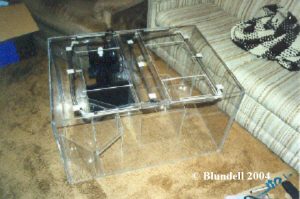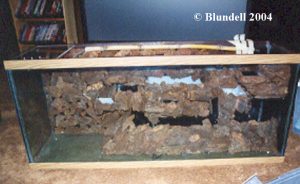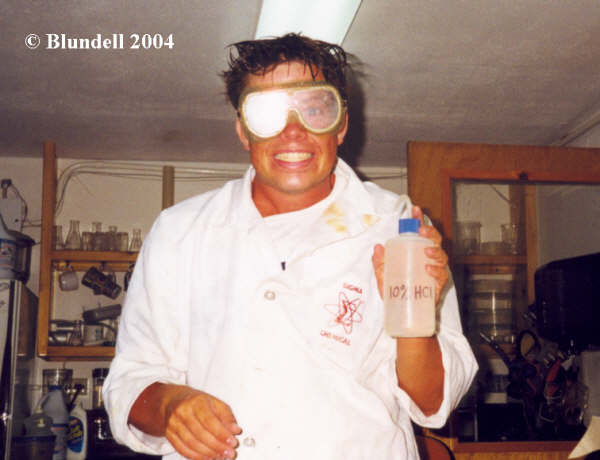Ever since the beginning of aquarium keeping there has been aquarium experimentation. I think we can all remember back to our first 10 gallon freshwater aquarium. We enjoyed arranging the plastic plants, installing a hang on filter, and turning on the light each morning. But of course it didn’t end there. It wasn’t long before you decided you could breed some mollies and sword tails, and maybe even modify a hang on filter to serve as your new baby fish fry growing tank.

Gail Blundell shown here inspecting a beautiful showpiece aquarium

Here are examples of home made aquariums complete with custom made acrylic dividers and supports.

During the past decade this attitude has flourished among the salt water reef aquarium keepers. The term Do It Yourself (DIY) has become synonymous with reef keeping. In fact internet search engines will often times direct more traffic to some hobbyists websites by using the search word “DIY” than any other word or phrase (author’s personal website statistics). With the increased cost of mechanical equipment utilized in reef keeping, there is of course more money to be saved by building items yourself. However, the money saved from DIY projects is not the real reason you should be experimenting with those projects. I’ll get back to this later (in the conclusion section).
What Type Of Items Can You Do Yourself
Everything.
What Are some Examples
I’ve seen so many items that people have made themselves. It is unbelievable to see the ingenuity and creativity that takes place in Do It Yourself projects. Additionally some projects maybe designed to replicate current products, without a personal touch to the project. The following are simple examples, starting from the most important reef aquarium items, to the fun additions that fuel the hobbyist flavor.

Phytoplankton cultures are of increasing popularity as more and more hobbyists begin their own home brews.
Aquariums
Twenty years ago you couldn’t find someone with home made aquarium. They were rare. Today a personal home made aquarium is no further found than to a friend’s house in your local aquarium club. Acrylic plastic fabrication is now a popular item commonly used by hobbyists to build aquariums. Even glass tanks are now being made by hobbyists to meet specific measurements to best fit their place in the home.

This showpiece aquarium was made by using one piece of glass from a broken aquarium. The other five sides are made of plywood.

Renowned aquarium photographer Corey Kruitbosch captures his amazing photographs in his two tank system, which he made himself out of custom cut glass.
Stands and Canopies
Now we’re getting away from acrylic and glass and now onto wood working. Yes stands and canopies can be found at any local pet store, but for many hobbyists the site of a stand in a store sparks a thought “I could build one of those”, and so they do. Often times the stands and canopies are simple (my euphemism for crude looking) items designed for a purpose. Other times these stands and canopies have intricate wood working to display the showcase aquarium. Personally, I’ve had to apologize to hobbyists after spending a half an hour looking at their aquarium only to realize I hadn’t actually looked at the aquarium (as I was preoccupied looking at the amazing stand they had built).

A complete, well designed home made stand.

Some people may like the looks of this canopy. But for the rest of us we can at least admit is serves its purpose.

Some people just can’t find enough ways to show how much they love seahorses.

The Plumbing
Is there a tank out there that doesn’t have home made plumbing? If so, I haven’t seen it.

A homemade overflow system

This hang on the back filter is shown on the author’s aquarium where it has been converted into a hang on refugium.

Closed loop systems provide great circulation, without needing a large pump.
The Big Additions
There is a group of aquarium items that are typically large, costly, and used in the more advanced aquarium systems. These items include protein skimmers, calcium reactors, and kalkwasser reactors. They may seem like more advanced projects, but in fact they usually have simple designs and principles. Local hobbyist clubs often have demonstrations on these items as a way to show people just how simple their construction is. Plans and diagrams on these items can be found online or by asking around with a group of fish friends.

This is a home made kalkwasser dosing pump.

Even very large protein skimmers can be home made.

A very rare but nice addition to an aquarium is a carbon filter.

Chris Singley is shown here describing how he makes his aragocrete rock structures.

“Chemical Jon” and Coral Planet owner Jake Pehrson are shown here teaching hobbyist club how to wire a lighting system.
The Small Additions
Small additions are items I consider to be a convenience or simply something that “looks way cool”. Most of the time these items are not made to save money, since the home made construction may cost the same or more than a store bought product. These items are just fun. Some of the most popular small scale projects today are moon lights.

You may think using car interior lights held to a clothes pin with a rubber band is a cheap way to make moon lights. Well, you’d be correct, which is why this picture was taken of the author’s moon lights.
Although moonlight is important in natural reef systems, in all reality it doesn’t have a useful purpose in the aquarium. Hobbyist try to argue that it does, but come on lets be honest here. we like moon lights because they look cool. Seeing items come out at night and seeing the blue nighttime glow, is simply fun. Another small addition that is gaining popularity is small float valves. These are typically installed in a sump area, and allow for a constant water top off. These items can be made cheaply, and do serve a purpose in the aquarium as a big time saver for maintenance.

Float systems are growing in popularity. Just remember eventually they will fail but don’t worry for you I’m sure it will be many many years from now.
The Oddities
What are the oddities? They are things that didn’t fit in any other category. Aquarium chemical expert Jon Finch makes his own calcium and alkalinity test kit reagents. Also, algal turf scrubbers, lighting pulley systems, refugia, and cooling fans are also commonly found.

Not everyone has Hydrochloric acid in their aquarium supplies, but home made test kits can be very informative on the processes of water chemistry.

Here an algal turf scrubber is placed between the display tank and the refugium below.

Having a lighting system on pulleys allows for easy maintenance.

Refugia can be made acrylic, small glass aquariums, or even plastic storage containers.

Here a picture of an internal Styrofoam refugia is shown. The owner suspects that it may be the world’s first floating refugium.


Fans of all shapes and sizes are bought at local stores and are attached to aquariums

Timing relays can be wired at home to control aquarium pumps for a wave making effect.

Sugar and yeast in a water bottle will provide months of CO2 gas bubbles using in aquariums.
Disclaimer
If you happen to burn your house down, flood your basement, shock yourself, or cause great bodily harm in the process of a Do It Yourself project, the author and the publishers of Advanced Aquarist Online Magazine claim no responsibility. Please consider all such unfortunate events to be your contribution to the scientific and experimental efforts of the marine aquarium hobby.

The author is shown here in his natural environment. Working in the lab.
Conclusion
I hadn’t paid much attention to the growing trend and online discussion of DIY until something important was brought to my attention. Expert reef keeper Shane Heil was explaining the reasons for DIY projects to a group of hobbyists. I learned from him the real key reason to taking on this adventurous attitude is to simply learn more about your system. If you built your own protein skimmer, calcium reactor, and water test kits, then you are certainly going to know more about how your system works. In reality, isn’t knowing more about your aquarium what this hobby is all about?
Acknowledgements
This article is dedicated to my father Gail Blundell and to my dear friend Mark Peterson. I can’t count how many times growing up that I would tell my dad that I bought some new lights and needed to wire them up. My dad would quickly run to the garage and get out all of the electrical tools. Thanks dad. Mark Peterson has spent a decade showing people that you can be cheap, have a tank, and have a cheap tank. I’ve never seen anyone as “super frugal” as Mark. The king of DIY he is widely known for his 24 hour help line, always ready to help rig up cheap tank.



0 Comments